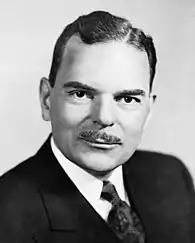1940 Republican Party presidential primaries
The 1940 Republican presidential primaries were the selection process by which voters of the Republican Party chose delegates to nominate a candidate President of the United States at the 1940 Republican National Convention. The nominee was selected at the convention in Philadelphia, Pennsylvania from June 24–28, 1940,.[1]
| |||||||||||||||||||||||||||||||||||||||||||
| |||||||||||||||||||||||||||||||||||||||||||
 Results map by state. | |||||||||||||||||||||||||||||||||||||||||||
| |||||||||||||||||||||||||||||||||||||||||||
The primaries were contested mainly by Manhattan District Attorney Thomas E. Dewey and Senators Robert A. Taft and Arthur Vandenberg, though only a few states' primaries featured two or more of these men.
By the start of the convention, only 300 of the 1,000 convention delegates had been pledged to a candidate, allowing businessman Wendell Willkie to be chosen as the Republican nominee without entering his name into any direct primaries or binding delegate selections.
Background
In the months leading up to the opening of the 1940 Republican National Convention, the three leading candidates for the GOP nomination were considered to be Senators Robert A. Taft of Ohio and Arthur Vandenberg of Michigan, and District Attorney Thomas E. Dewey of New York.
Taft was the leader of the GOP's conservative, isolationist wing, and his main strength was in his native Midwest and parts of the South.
Vandenberg, the senior Republican in the Senate, was the "favorite son" candidate of the Michigan delegation and was considered a possible compromise candidate.
Dewey, the District Attorney for Manhattan, had risen to national fame as the "Gangbuster" prosecutor who had sent numerous infamous mafia figures to prison, most notably "Lucky" Luciano, the organized-crime boss of New York City. In one of the most-watched races of the 1938 midterm elections, Dewey narrowly lost the New York gubernatorial election to incumbent Herbert Lehman.
However, each of the three leading candidates had exploitable weaknesses. Taft's outspoken isolationism and opposition to any American involvement in the European war convinced many Republican leaders that he could not win a general election. Dewey's relative youth – he was only 38 in 1940 – lack of foreign-policy experience weakened his candidacy as the Nazi threat emerged.
With less than one-third of convention delegates bound to any candidate through the primary campaign, an opening for a dark horse candidate existed.
Candidates
The following political leaders were candidates for the 1940 Republican presidential nomination:
Major candidates
These candidates participated in multiple state primaries or were included in multiple major national polls.
Competing in primaries
| Candidate | Most recent position | Home state | Campaign | ||
|---|---|---|---|---|---|
| Thomas E. Dewey |  |
Manhattan District Attorney (1938–41) |
 New York |
(Campaign) | |
| Robert A. Taft | 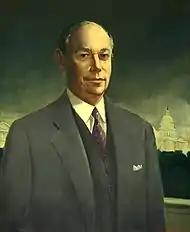 |
U.S. Senator from Ohio (1939–53) |
 Ohio |
(Campaign) | |
| Arthur Vandenberg | 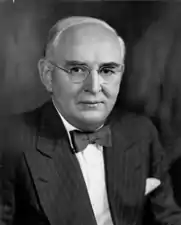 |
U.S. Senator from Michigan (1939–53) |
 Michigan |
||
Bypassing primaries
The following candidates did not actively campaign for any state's presidential primary, but may have had their name placed on the ballot by supporters or may have sought to influence to selection of un-elected delegates or sought the support of uncommitted delegates.
| Candidate | Most recent position | Home state | Campaign | |
|---|---|---|---|---|
| Styles Bridges |  |
Senator from New Hampshire (1937–61) |
 New Hampshire |
|
| Herbert Hoover |  |
Former President of the United States (1929–33) |
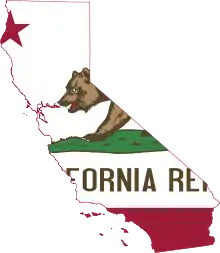
|
(Campaign) |
| Arthur James |  |
Governor of Pennsylvania (1939–43) |
 Pennsylvania |
|
| Frank Gannett |  |
Newspaper publisher |  New York |
|
| Wendell Willkie | 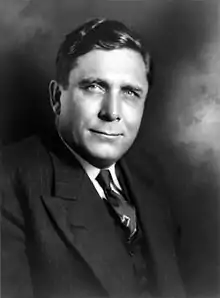 |
Businessman |  New York |
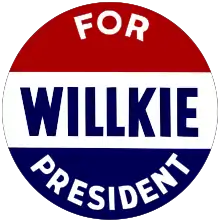 (Campaign) |
Favorite sons
The following candidates ran only in their home state's primary or caucus for the purpose of controlling its delegate slate at the convention and did not appear to be considered national candidates by the media.
- Governor Harland Bushfield of South Dakota
- Senator Arthur Capper of Kansas
- Ryan N. Davis of West Virginia
- House Minority Leader Joseph W. Martin of Massachusetts
- Former Ambassador Hanford MacNider of Iowa
- Senate Minority Leader Charles L. McNary of Oregon
- Charles Montgomery of Ohio
- State Senator Jerrold L. Seawell of California
Declined to run
The following persons were listed in a major national poll or were the subject of media speculation surrounding their potential candidacy, but declined to actively seek the nomination.
- Governor George Aiken of Vermont (ran for U.S. Senate)
- Representative Bruce Barton of New York (ran for U.S. Senate) (endorsed Willkie)
- Senator William Borah of Idaho (died January 19, 1940)
- Governor John W. Bricker of Ohio
- Representative Hamilton Fish III of New York (withdrew from consideration February 25, 1940)
- Businessman Henry Ford of Michigan
- Former University President Glenn Frank of Wisconsin (ran for U.S. Senate and died September 15, 1940)
- Mayor Fiorello La Guardia of New York (endorsed President Roosevelt)[2]
- Former Governor Alf Landon of Kansas
- Aviator Charles Lindbergh of New Jersey
- Senator Henry Cabot Lodge Jr. of Massachusetts
- Senator Hiram Johnson of California
- Publisher Frank Knox (appointed as Secretary of the Navy on July 11, 1940)
- Theodore Roosevelt Jr. of New York
- Governor Harold Stassen of Minnesota (endorsed Willkie)
- Governor William Henry Vanderbilt III of Rhode Island (endorsed Willkie)[3]
- Representative James W. Wadsworth Jr. of New York
Polling
National polling
| Source | Publication | ||||||
|---|---|---|---|---|---|---|---|
| Gallup[4] | May 21, 1938 | ? | ? | – | 35% | – | ?[lower-alpha 1] |
| Gallup[5] | Nov. 27, 1938 | 33% | 6% | 18% | 18% | – | 25%[lower-alpha 2][lower-alpha 3] |
| Gallup[6] | Feb. 17, 1939 | 27% | 4% | 16% | 21% | – | 32%[lower-alpha 4][lower-alpha 5] |
| Gallup[7] | Mar. 22, 1939 | 50% | 5% | 13% | 15% | – | 23%[lower-alpha 6][lower-alpha 7] |
| Gallup[8] | May 10, 1939 | 54% | 4% | 15% | 13% | – | 14%[lower-alpha 8] |
| Gallup[9] | July 8, 1939 | 47% | 6% | 13% | 19% | – | 15%[lower-alpha 9] |
| Gallup[10] | Aug. 13, 1939 | 45% | 6% | 14% | 25% | – | 10%[lower-alpha 10] |
| Gallup[11] | Oct. 13, 1939 | 39% | 5% | 17% | 27% | – | 12%[lower-alpha 11] |
| Gallup[12] | Nov. 10, 1939 | 39% | 5% | 18% | 26% | – | 12%[lower-alpha 12][lower-alpha 13] |
| 44% | – | 25% | 31% | – | – | ||
| Gallup[13] | Jan. 7, 1940 | 60% | 5% | 11% | 16% | – | 8%[lower-alpha 14] |
| Gallup[14][15] | Feb. 1940 | 56% | 3% | 17% | 17% | – | 7%[lower-alpha 15] |
| 35% | 2% | 11% | 11% | – | 41%[lower-alpha 16] | ||
| Gallup[15] | Mar. 24, 1940 | 53% | 5% | 17% | 19% | – | 6%[lower-alpha 17] |
| 32% | 3% | 10% | 11% | – | 44%[lower-alpha 18] | ||
| Gallup[16][17] | May 8, 1940 | 67% | 2% | 12% | 14% | 3% | 2%[lower-alpha 19] |
| Gallup[17] | May 17, 1940 | 62% | 2% | 14% | 13% | 5% | 4%[lower-alpha 20] |
| Gallup | May 1940 | 56% | 2% | 16% | 12% | 10% | |
| Gallup[18] | June 12, 1940 | 52% | 2% | 13% | 12% | 17% | 4%[lower-alpha 21] |
| Gallup[18] | June 21, 1940 | 47% | 6% | 8% | 8% | 29% | 2%[lower-alpha 22] |
- Others mentioned but not counted included Thomas Dewey, Henry Cabot Lodge, Alf Landon, Herbert Hoover, and Glenn Frank.
- Alf Landon with 6%, Henry Cabot Lodge Jr. with 5%, and Arthur James with 2%
- Others mentioned but not counted included William Borah, Bruce Barton, and John Bricker.
- Alf Landon with 7%, William Borah with 4%, and Fiorello LaGuardia with 4%
- Other mentioned but not counted included Frank Knox, Henry Cabot Lodge, Arthur James, Bruce Barton, John Bricker, Leverett Saltonstall, George Aiken, James J. Wadsworth, Theodore Roosevelt Jr., Henry Ford, Harold Stassen, Arthur Capper, Julius Heil, Frank Gannett, Gerald Nye, and Hamilton Fish
- Alf Landon with 4% and William Borah with 2%
- Others named but not counted included Frank Knox, Hiram Johnson, Gerald Nye, George Aiken, Bruce Barton, Arthur James, Leverett Saltonstall, John Bricker, Fiorello LaGuardia, Theodore Roosevelt Jr., Frank Gannett, and Arthur Capper
- William Borah with 3%, Alf Landon with 3%, John Bricker with 1%, Henry Cabot Lodge with 1%, Fiorello LaGuardia with 1%, Bruce Barton with 1%, "All Others" with 4%
- Alf Landon with 4%, William Borah with 3%, Fiorello LaGuardia with 2%, Henry Cabot Lodge Jr. with 1%, John Bricker with 1%, and "All Others" with 4%
- Alf Landon with 3%, William Borah with 2%, John Bricker with 2%, and Others with 3%
- Alf Landon with 3%, William Borah with 3%, Charles Lindbergh with 1%, Henry Cabot Lodge with 1%, and Others with 4%
- Alf Landon with 3%, William Borah with 3%, Charles Lindbergh with 1%, Henry Cabot Lodge Jr. with 1%, and Others with 4%
- Among "Others", those receiving most frequent mention included Styles Bridges, Leverett Saltonstall, and William Vanderbilt.
- Arthur James with 1%, Henry Cabot Lodge Jr. with 1%, John Bricker with 1%, William Borah with 1%, Alf Landon with 1% and All others with 3%
- Frank Gannett with 1% and all others with 6%
- Frank Gannett with 1% and all others with 4%. 36% were undecided.
- Frank Gannet with 1%, Arthur James with 1%, and all others with 4%
- Frank Gannett with 1%, Arthur James with 1%, and all others with 2%. 40% were undecided.
- Others with 2%
- Frank Gannett with 1%, Styles Bridges with 1%, and Others with 2%
- Alf Landon with 1%, Frank Gannett with 1%, and Others with 2%
- Others with 2%
Illinois
| Source | Publication | ||||||
|---|---|---|---|---|---|---|---|
| Gallup[19] | Aug. 2, 1939 | 45% | 8% | 12% | 14% | – | 21%[lower-alpha 1] |
Massachusetts
| Source | Publication | ||||||
|---|---|---|---|---|---|---|---|
| Gallup[20] | Aug. 14, 1939 | 45% | 8% | 12% | 14% | – | 21%[lower-alpha 2] |
Michigan
| Source | Publication | ||||||
|---|---|---|---|---|---|---|---|
| Gallup[21] | Aug. 15, 1939 | 29% | 1% | 5% | 62% | – | 3%[lower-alpha 3] |
Ohio
| Source | Publication | ||||||
|---|---|---|---|---|---|---|---|
| Gallup[22] | Aug. 7, 1939 | 29% | 3% | 33% | 19% | – | 16%[lower-alpha 4] |
Wisconsin
| Source | Publication | ||||||
|---|---|---|---|---|---|---|---|
| Gallup | Aug. 15, 1939 | 37% | 5% | 16% | 24% | – | 18%[lower-alpha 5] |
Statewide contests
March 12 – New Hampshire
The New Hampshire primary was the first in the nation and widely considered one of the most notable at the outset of the process. The state elected four delegates at-large and two from each of the state's two congressional districts.[23]
Though all delegates were formally uncommitted, J. Howard Gile of Nashua announced his intention to vote for Thomas Dewey — against the Dewey campaign's wishes. The Dewey campaign asked Gile to withdraw from the race; it was assumed Dewey had bypassed New Hampshire in respect and recognition of favorite-son presidential candidate Senator Styles Bridges, who ran as a delegate at-large.[23]
In the Second Congressional District, James P. Richardson expressed his support of Dewey but did not formally pledge himself to any candidate. Most of the elected delegates expressed a non-binding preference for Senator Bridges.[24]
| Delegates At-Large (4) | 1st Cong. District (2) | 2nd Cong. District (2) | |||
|---|---|---|---|---|---|
| Candidate | Votes | Candidate | Votes | Candidate | Votes |
| Styles Bridges | Arthur B. Jenks | Foster W. Stearns | |||
| Charles W. Tobey | Charles Greenman | James C. Farmer | |||
| Francis P. Murphy | James P. Richardson | ||||
| J. Howard Gile | Robert C. Upton | ||||
| George H. Moses | |||||
| Huntley N. Spaulding | |||||
| Joseph Moore | |||||
| William J. Britton | |||||
| Date | Primary | Thomas Dewey | Unpledged
(Bridges) |
|---|---|---|---|
| March 12 | New Hampshire | 0% | 100% |
April 2 – Wisconsin
The first competitive race was between Dewey and Vandenberg in Wisconsin. The state was expected to be favorable to Vandenberg, the Senator from neighboring Michigan. Vandenberg was also an opponent of expanded trade agreements, a supporter of dairy and beet farmers, an isolationist, and a supporter of the St. Lawrence Waterway project — all positions expected to gain him strong support in the state. It was also said that Vandenberg had the stronger, more popular slate of delegates.[25] He was also seen to have the support of the state's many Progressive Party voters as against Dewey, but may have been hurt by those voters' last-second swing to support President Roosevelt in the Democratic primary.[26][27]
Dewey gained support from voters and political leaders by announcing his support for the expansion of the St. Lawrence Waterway. After his endorsement, many of the state's Congressmen opted not to take sides in the race. Dewey also took a hit when the leadership of the state's active Progressive Party objected to a Dewey supporter's use of "Progressive" in campaign material.[25]
Taft did not compete in the state.
Dewey, unlike Vandenberg, personally campaigned in Wisconsin. He held a barnstorming tour across the state in the final week of March.[27]
Although Wisconsin held a delegate election and a preference poll on primary day, Dewey's name was not entered the latter; his campaign opted only to run a slate of delegates.[27]
On election day, Dewey delegates won handily.
| Date | Primary | Dewey | Vandenberg |
|---|---|---|---|
| April 2 | Wisconsin | 73% | 27% |
April 9 – Illinois
The Illinois primary was initially expected to be one of the more competitive votes of the process. Congressman Hamilton Fish III filed to run in the election as an isolationist candidate, but later withdrew his name.[28][29] Dewey was considered the heavy favorite to win the primary regardless.[30]
Mayor of New York Fiorello La Guardia was also submitted as a candidate without his knowledge, but did not sign a statement of candidacy necessary to appear on the ballot and declined to be considered.[2][28]
Dewey was left unopposed in the state's preference poll.[29] None of the state's delegates, who were elected separately, were bound by the "advisory" result.[31]
| Date | Primary | Thomas Dewey |
|---|---|---|
| April 9 | Illinois | 100% |
April 9 – Nebraska
| Date | Primary | Dewey | Vandenberg |
|---|---|---|---|
| April 9 | Nebraska | 59% | 41% |
April 23 – Pennsylvania
| Date | Primary | Thomas Dewey | Arthur James | Robert A. Taft | Arthur Vandenberg | Wendell Willkie | Herbert Hoover | Unpledged |
|---|---|---|---|---|---|---|---|---|
| April 23 | Pennsylvania | 67% | 10% | 7% | 3% | 1% | 1% | 0% |
April 30 – Massachusetts
In Massachusetts, all delegates were as a rule formally uncommitted, but could pledge themselves to a candidate if they wished. Two delegates from Springfield, Dudley Wallace and Clarence Brooks, attempted to pledge themselves to Dewey but were not granted the privilege.[32]
In general, the division was not based on any presidential candidacy but was between an establishment Republican slate and an insurgent Townsendite slate supporting the institution of an old-age pension.[32]
The establishment slate listed as delegates at-large Governor Leverett Saltonstall, Senator Henry Cabot Lodge Jr., U.S. House Minority Leader Joseph W. Martin Jr., and State Treasurer John W. Haigis. The insurgent slate listed William H. McMasters, Byron P. Hayden, Harry P. Gibbs, and Seldon G. Hill.[32]
| Party | Candidate | Votes | % | |
|---|---|---|---|---|
| Republican | Leverett Saltonstall | 62,152 | 22.11% | |
| Republican | Henry Cabot Lodge, Jr. | 61,539 | 21.89% | |
| Republican | John W. Haigis | 55,379 | 19.51% | |
| Republican | Joseph W. Martin Jr. | 54,845 | 19.51% | |
| Republican | William H. McMaster | 14,091 | 5.01% | |
| Republican | Byron P. Hayden | 11,489 | 4.09% | |
| Republican | Henry P. Gibbs | 10,845 | 3.86% | |
| Republican | Selden G. Hill | 10,756 | 3.83% | |
| Total votes | 281,117 | 100.00% | ||
May 5 – South Dakota
| Date | Primary | Unpledged |
|---|---|---|
| May 5 | South Dakota | 100% |
May 6 – Maryland
| Date | Primary | Thomas Dewey |
|---|---|---|
| May 6 | Maryland | 100% |
May 7 – California
| Date | Primary | Jerrold Seawell |
|---|---|---|
| May 7 | California | 100% |
May 14 – Ohio
| Date | Primary | Robert A. Taft |
|---|---|---|
| May 14 | Ohio | 100% |
May 14 – West Virginia
| Date | Primary | Ryan N. Davis |
|---|---|---|
| May 14 | West Virginia | 100% |
May 17 – Oregon
| Date | Primary | Thomas Dewey | Charles McNary |
|---|---|---|---|
| May 17 | Oregon | 4% | 96% |
May 21 – New Jersey
Following the results of the Wisconsin primary, Robert Taft withdrew his name from the New Jersey preference primary ballot, leaving Dewey unopposed.[33] However, Wendell Willkie received a strong 5.55% of the vote as a write-in candidate.
| Party | Candidate | Votes | % | |
|---|---|---|---|---|
| Republican | Thomas Dewey | 340,734 | 93.85% | |
| Republican | Wendell Willkie (write-in) | 20,143 | 5.55% | |
| Democratic | Franklin D. Roosevelt (write-in) | 1,202 | 0.33% | |
| Republican | Robert A. Taft (write-in) | 595 | 0.16% | |
| Republican | Arthur Vandenberg (write-in) | 168 | 0.05% | |
| Republican | Arthur James (write-in) | 81 | 0.02% | |
| Republican | Herbert Hoover (write-in) | 69 | 0.02% | |
| Republican | Frank Gannett (write-in) | 31 | 0.01% | |
| Republican | Charles Lindbergh (write-in) | 12 | 0.00% | |
| Democratic | Cordell Hull (write-in) | 10 | 0.00% | |
| Republican | Fiorello LaGuardia (write-in) | 6 | 0.00% | |
| Total votes | 363,082 | 100.00% | ||
Post-primary events and Convention
The Nazi Army's rapid blitz into France in May 1940 shook American public opinion, even as Taft was telling a Kansas audience that America must concentrate on domestic issues to prevent Roosevelt from using the international crisis to extend socialism at home. Both Dewey and Vandenberg also continued to oppose any aid to Britain that might lead to war with Germany. Nevertheless, sympathy for the embattled British was mounting daily, and this aided Willkie's candidacy. By mid-June, little over one week before the Republican Convention opened, the Gallup poll reported that Willkie had moved into second place with 17%, and that Dewey was slipping. Fueled by his favorable media attention, Willkie's pro-British statements won over many of the delegates. As the delegates were arriving in Philadelphia, Gallup reported that Willkie had surged to 29%, Dewey had slipped 5 more points to 47%, and Taft, Vandenberg and former President Herbert Hoover trailed at 8%, 8%, and 6% respectively. Hundreds of thousands, perhaps as many as one million, telegrams urging support for Willkie poured in, many from "Willkie Clubs" that had sprung up across the country. Millions more signed petitions circulating everywhere.
At the 1940 Republican National Convention itself, keynote speaker Harold Stassen, the Governor of Minnesota, announced his support for Willkie and became his official floor manager. Hundreds of vocal Willkie supporters packed the upper galleries of the convention hall. Willkie's amateur status, his fresh face, appealed to delegates as well as voters. The delegations were selected not by primaries but by party leaders in each state, and they had a keen sense of the fast-changing pulse of public opinion. Gallup found the same thing in polling data not reported until after the convention: Willkie had moved ahead among Republican voters by 44% to only 29% for the collapsing Dewey. As the pro-Willkie galleries repeatedly yelled "We Want Willkie", the delegates on the convention floor began their vote. Dewey led on the first ballot but steadily lost strength thereafter. Both Taft and Willkie gained in strength on each ballot, and by the fourth ballot it was obvious that either Willkie or Taft would be the nominee. The key moments came when the delegations of large states such as Michigan, Pennsylvania, and New York left Dewey and Vandenberg and switched to Willkie, giving him the victory on the sixth ballot. The voting went like this:
| ballot: | 1 | 2 | 3 | 4 | 5 | 6 |
|---|---|---|---|---|---|---|
| Thomas E. Dewey | 360 | 338 | 315 | 250 | 57 | 11 |
| Ohio Senator Robert A. Taft | 189 | 203 | 212 | 254 | 377 | 310 |
| Wendell L. Willkie | 105 | 171 | 259 | 306 | 429 | 633 |
| Michigan Senator Arthur Vandenberg | 76 | 73 | 72 | 61 | 42 | - |
| Pennsylvania Governor Arthur H. James | 74 | 66 | 59 | 56 | 59 | 1 |
| Massachusetts Rep. Joseph W. Martin | 44 | 26 | - | - | - | - |
| Hanford MacNider | 32 | 34 | 28 | 26 | 4 | 2 |
| Frank E. Gannett | 33 | 30 | 11 | 9 | 1 | 1 |
| New Hampshire Senator Styles Bridges | 19 | 9 | 1 | 1 | - | - |
| Former President Herbert Hoover | 17 | - | - | - | 20 | 9 |
| Oregon Senator Charles L. McNary | 3 | 10 | 10 | 8 | 9 | - |
Willkie's nomination is still considered by most historians to have been one of the most dramatic moments in any political convention. Having given little thought to who he would select as his vice-presidential nominee, Willkie left the decision to convention chairman and Massachusetts Congressman Joe Martin, the House Minority Leader, who suggested Senate Minority Leader Charles L. McNary of Oregon. Despite the fact that McNary had spearheaded a "Stop Willkie" campaign late in the balloting, the candidate picked him to be his running mate.
| Charles L. McNary | 848 |
| Dewey Short | 108 |
| Styles Bridges | 2 |
Notes
- Henry Cabot Lodge Jr. with 14%, Al Landon with 2%, Styles Bridges with 2%, and Others with 3%
- Henry Cabot Lodge Jr. with 14%, Al Landon with 2%, Styles Bridges with 2%, and Others with 3%
- Alf Landon with 2% and Others with 1%
- John Bricker with 12%, Alf Landon with 1%, and Others with 3%
- Fiorello LaGuardia with 4% and "Others" with 14% (including William Borah, Alf Landon, Henry Cabot Lodge Jr., and Styles Bridges)
References
- Kalb, Deborah (2016-02-19). Guide to U.S. Elections - Google Books. ISBN 9781483380353. Retrieved 2016-02-19.
- "La Guardia Drops Out of Illinois Primary; 'Phooey!' He Says of Republican Aspirants". The New York Times. 24 Feb 1940. p. 1.
- "VANDERBILT BACKS WILLKIE CANDIDACY". The New York Times. 16 June 1940. p. 20.
- Gallup, George (22 May 1938). "Vandenberg Holds G.O.P. Preference". Los Angeles Times. p. A5.
- Gallup, George (27 Nov 1938). "Rank and File Of Republicans Want New Faces Survey Shows". The Baltimore Sun. p. SM1.
- Gallup, George (17 Feb 1939). "Dewey, Vandenberg and Taft Lead in Gallup G. O. P. Poll". The Boston Daily Globe. p. 17.
- Gallup, George (22 Mar 1939). "Dewey Popularity For 1940 Boosted By Hines Conviction". The Baltimore Sun. p. 13.
- Gallup, George (10 May 1939). "Dewey and Taft Gain in Republican Popularity". Los Angeles Times. p. 26.
- "Vandenberg Gains in Voters' Survey". The New York Times. 8 Jul 1939. p. 2.
- Gallup, George (13 Aug 1939). "Vandenberg's Popularity Rises Sharply, Survey Of Republican Voters Shows". The Atlanta Constitution. p. 15A.
- Gallup, George (13 Oct 1939). "Dewey Maintains Lead in G.O.P. But Drops in Popularity Since War Began". The Washington Post. p. 2.
- Gallup, George (10 Nov 1939). "Dewey Holds 1940 Lead in Survey of Republicans". The Daily Boston Globe. p. 17.
- Gallup, George (7 Jan 1940). "Dewey Increases His Lead for Republican Nomination". Daily Boston Globe. p. 26.
- Gallup, George (11 Feb 1940). "Taft, Vandenberg Gain in Survey Of G. O. P. Voters But Dewey Leads". The Atlanta Constitution. p. 12A.
- Gallup, George (24 Mar 1940). "Dewey vs. Vandenberg Test Indicates Close Contests". Los Angeles Times. p. A5.
- "POPULARITY GAIN SHOWN BY WILLKIE: 'DarkHorse' Has Jumped Ahead of Hoover and Landon". The New York Times. 8 May 1940. p. 18.
- "WILLKIE IS CALLED CHIEF 'DARK HORSE': He Has 'Jumped From Nowhere to 4th Place in List'". The New York Times. 17 May 1940. p. 15.
- Gallup, George (21 June 1940). "Dewey and Willkie Lead on Convention's Eve". Daily Boston Globe. p. 28.
- Gallup, George (2 Aug 1939). "Illinois Swing to G.O.P. Shown by Gallup Survey: Prairie State, Along With New York and Pennsylvania, Drifting From Democratic Fold". Los Angeles Times. p. 4.
- "Voters In Massachusetts Still Favor G. O. P.; Dewey, Garner Preferred for 1940". The Atlanta Constitution. 14 Aug 1939. p. 7.
- "Michigan Leans to G. O. P,; Vandenberg Leads Dewey, Popularity Survey Shows". The Atlanta Constitution. 9 Aug 1939. p. 4.
- "Ohio, One of Key States, Favors Return to Fold Of G.O.P. Survey Shows". The Atlanta Constitution. 7 Aug 1939. p. 8.
- "Presidential Tests at Polls Open Tuesday: New Hampshire's Voters Will Have Opportunity to Support a DeweyMan Gamer and Farley Candidates Also Up 1936 Delegation Head, Pledged to Roosevelt, Excluded From Slate". The New York Herald Tribune. 10 Mar 1940. p. A1.
- Robert Taft Jr. with 4%, Mark Hatfield and Charles Percy with 2% each
- Blair, Edson (1 Apr 1940). "Washington: Both Sides of the Curtain ..: Much at Stake for Both Dewey and Vandenberg in This Week's Wisconsin Primary". Barron's. p. 4.
- John Lindsay with 5%, Robert Taft Jr. with 3%, Mark Hatfield with 2%, and Charles Percy with 1%
- Fleming, Dewey (2 Apr 1940). "La Follettes Drifting Back To Roosevelt Band Wagon: Most Progressives Expected To Support President Today". The Baltimore Sun. p. 1.
- "LaGuardia's Name Filed in Illinois Race: Entered as a Republican Presidential Candidate, Says He Didn't Know It Garner Files to Run Against Roosevelt Hamilton Fish Is Placed on Ballot to Compete With Mayor and Dewey". New York Herald Tribune. 10 Feb 1940. p. 1.
- "Dewey Left Unopposed For Primary in Illinois: Fish's Withdrawal Follows Action by LaGuardia". The New York Herald Tribune. 25 Feb 1940. p. 6.
- John Lindsay with 2%, Robert Taft Jr. with 2%, Mark Hatfield and Charles Percy with 1% each
- John Lindsay with 4%, Robert Taft Jr. with 3%, Mark Hatfield with 2%, and Charles Percy with 1%
- Hagerty, James (14 Mar 1940). "G.O.P. Regulars Face Contests Pledges Not Binding". The New York Times. p. 18.
- John Lindsay with 4%, Robert Taft Jr. with 4%, Charles Percy with 2% and Mark Hatfield with 1%
